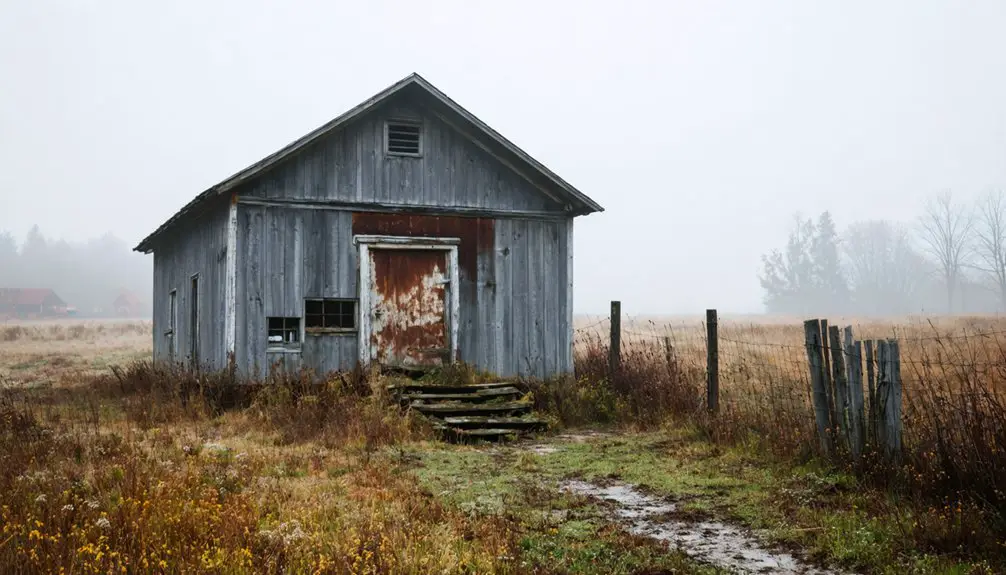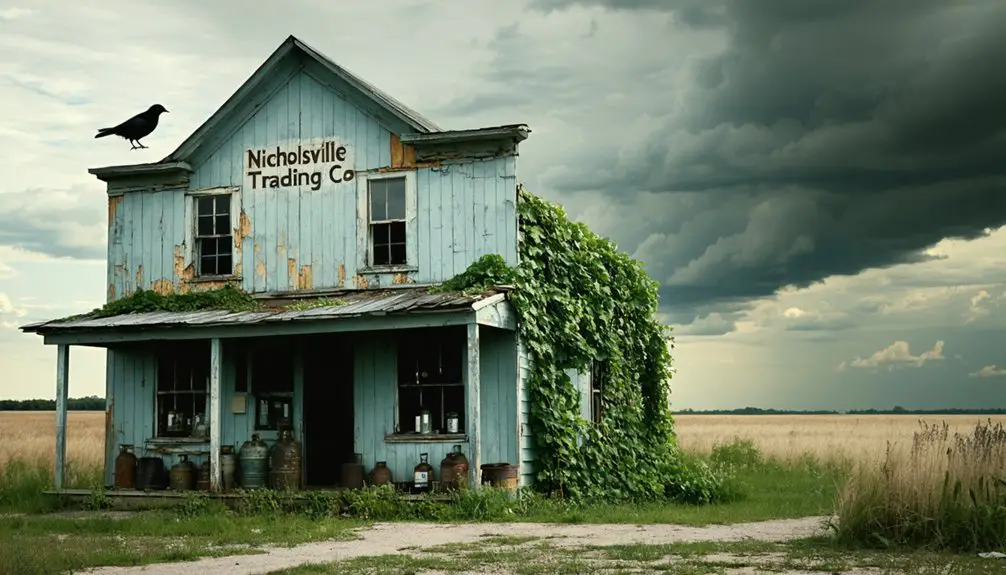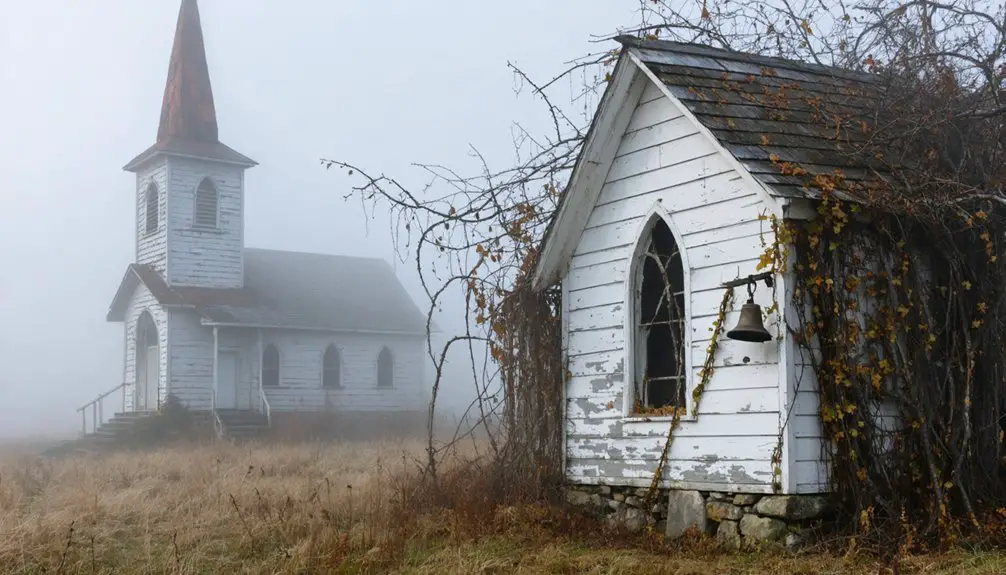You’ll find Nicholsville’s ghostly remnants tucked away in Michigan’s former lumber country, where the Nichols brothers established their sawmill town in 1851. Once buzzing with immigrant workers and their families, the town thrived on timber production and flour milling until the 1920s. When the lumber ran out, workers left for the Upper Peninsula’s mines, leaving behind empty homes and crumbling foundations. Nature’s steady reclamation of this industrial settlement holds countless untold stories.
Key Takeaways
- Founded in 1851 by Jonathon and Marshall Nichols around a sawmill, Nicholsville grew into a thriving industrial town in Michigan.
- The town’s economy centered on lumber mills and flour production, with the Chicago & Western Michigan Railroad boosting growth.
- Hundreds of immigrant workers and families, mainly Finnish, Swedish, and Norwegian, formed tight-knit communities around the mills.
- Economic decline began in the 1920s when sawmills relocated to the Upper Peninsula, leading to mass exodus.
- The town transformed into a ghost town after resource depletion, leaving only ruins and foundations now surrounded by wetlands.
Early Settlement and Town Origins

While many Michigan ghost towns emerged from mining booms, Nicholsville’s story began with two ambitious brothers and their vision for a mill town. In 1851, Jonathon and Marshall Nichols arrived at a promising location where settlement dynamics were already taking shape around an existing sawmill.
They quickly purchased the mill and expanded their operations by adding a grist mill, setting the foundation for a self-sustaining community. Like early Port Crescent lumber town, Nicholsville’s economy centered heavily on timber processing in its early days.
The brothers’ commitment to community formation went beyond industrial development. They built houses for workers and their families, creating a permanent population base centered around the mills. This early housing approach was similar to how immigrant families later occupied small wooden houses in other Michigan industrial communities.
Visionary mill owners didn’t just build industry – they created homes, fostering a thriving community where workers could put down roots.
You can trace Nicholsville’s early identity through its practical development – a place where timber met grain, where mill workers established homes, and where the Nichols brothers’ entrepreneurial spirit sparked a new settlement in Michigan’s rapidly developing landscape.
Resource-Based Industrial Growth
As Nicholsville’s mills hummed with activity, the town’s growth mirrored the resource-driven industrial expansion sweeping through southwestern Michigan.
The bustling town echoed the success of Lily White Flour, a renowned brand produced at mills in the region.
You’d have seen bustling resource extraction operations taking advantage of the area’s abundant timber and water power, much like neighboring towns such as Middleville and Woodville.
The Chicago & Western Michigan Railroad had completed its tracks through the region by 1873, accelerating the town’s growth and timber operations.
The town’s industrial clusters grew around the rhythmic churning of flour mills and the sharp whine of sawmills.
Railroad tracks brought life-giving connections, letting Nicholsville’s lumber flow to hungry markets while supporting a web of wagon works, blacksmith shops, and general stores.
Local farmers brought their grain to the mills, while timber crews worked the surrounding forests.
It’s a familiar tale of how Michigan’s natural bounty shaped not just commerce, but the very fabric of pioneer communities.
Peak Economic Years and Community Life
The bustling mills of Nicholsville drew scores of European immigrant families seeking steady work, transforming the once-quiet settlement into a vibrant industrial community.
You’d have found these hardworking folk living in close-knit neighborhoods near the sawmill and grist mill, where the daily rhythms of industrial life shaped their routines. Like many towns that relied on one-industry economies, Nicholsville’s fate was sealed when market conditions changed.
As mill workers earned their wages, the town came alive with general stores, social gatherings, and holiday celebrations that bound the community together through shared traditions and mutual support. The town’s prosperity would eventually fade as resource depletion forced many families to seek opportunities elsewhere.
Industry Workers and Families
During Nicholsville’s peak years, hundreds of workers and their families built a tight-knit community centered around Michigan’s booming lumber trade. You’d find men laboring in the sawmills and forests, while their families crafted a life amid the sounds of timber being hewn and processed. Similar to life in Central Mine, women took on crucial roles managing households and caring for boarders.
Worker solidarity emerged from shared challenges – long hours in harsh weather, dangerous conditions, and the uncertainty of seasonal work. These hardy folks supported each other through thick and thin. Similar to the workers in other lumber towns, the laborers faced economic uncertainty when railroad access became limited.
Family dynamics revolved around the industry’s demands, with relatives often working side by side. You’d see children helping with small tasks, wives managing households, and multiple generations contributing to the family’s survival.
Their modest homes, clustered near the mills and camps, buzzed with the spirit of a community determined to thrive despite the rugged conditions.
Community Events and Commerce
While workers forged strong bonds through their shared labor, Nicholsville’s vibrant community life sprang from its bustling commercial district and spirited social gatherings.
You’d find general stores stocking mining gear alongside daily essentials, while blacksmiths and food vendors served the town’s growing population. The post office wasn’t just for mail – it connected you to the wider world and kept commerce flowing smoothly. Similar to Central Mine’s peak years, the town supported over 1,300 residents. The traditional Finnish sisu spirit shaped the resilient character of the townspeople and their approach to daily life.
Community gatherings centered around the church and schools, where you’d join neighbors for social events that strengthened the town’s social cohesion.
Local saloons offered entertainment after long days in the mines, while annual reunions and picnics brought everyone together. The town’s multipurpose buildings hosted markets and celebrations, turning simple structures into thriving hubs of both commerce and culture.
The Decline Era: Causes and Effects
You’d find Nicholsville’s dramatic decline followed patterns seen across Michigan’s ghost towns, where the depletion of timber resources sparked a chain reaction of economic collapse.
When the sawmills shuttered and relocated their equipment to the Upper Peninsula in the early 1920s, workers and their families began a steady exodus that transformed the once-bustling community.
The town’s fate was sealed by its lack of economic diversity, as the single-industry dependency left no alternative employment to sustain the population, leading to abandoned homes and deteriorating infrastructure.
Economic Downturn Impact Analysis
As the mighty Cummer-Diggins chemical plant shuttered its doors in the early 1920s, Nicholsville’s fate became inextricably linked to the broader economic collapse sweeping through Michigan’s industrial towns.
You’d have witnessed the town’s economic resilience crumble as businesses closed one by one – hotels, saloons, and stores falling like dominoes.
The migration trends revealed a harsh truth: workers, including Finnish, Swedish, and Norwegian laborers who’d built the community, packed up and headed to places like Cadillac or the Upper Peninsula in search of work.
Property values plummeted as homes stood empty, some even relocated to other towns.
The tax base dwindled, leaving infrastructure to decay.
What remained was a shell of a once-thriving industrial community, its spirit broken by economic necessity.
Resource Depletion Timeline
When copper veins ran deep beneath Nicholsville’s soil in the late 1800s, few could have predicted the devastating cycle of resource depletion that would transform this bustling mining town into a ghost of its former self.
You’ll find the timeline of decline began with intensive copper mining that rapidly exhausted the rich, accessible veins by century’s end. By 1898, the Central Mine had closed, marking a turning point in Nicholsville’s fate.
As mining companies pushed deeper underground, they faced mounting technical challenges and dwindling ore quality. The town’s resource management proved unsustainable – deforestation stripped the land while toxic mine waste poisoned local waters.
Through the early 1900s, fluctuating copper prices and the 1913 miners’ strike delivered the final blows to Nicholsville’s already fragile economy.
Population Exodus Patterns
The devastating population exodus from Nicholsville began not with a sudden crash, but through a steady trickle that soon became a flood.
You’d have seen the first signs as younger residents packed up for bigger cities, seeking opportunities their dwindling hometown couldn’t provide. Population trends showed a clear pattern: when the main employer shuttered operations, workers and their families had little choice but to leave.
Migration patterns revealed how ethnic communities that once gave Nicholsville its vibrant character dispersed to urban centers.
The town’s social fabric unraveled as churches closed their doors and schools consolidated elsewhere. Those who stayed watched their neighbors’ homes empty one by one, until even the most rooted families realized they couldn’t sustain their way of life in a place that was slowly fading away.
Geographic Features and Regional Impact
Nestled within Michigan’s Upper Peninsula, Nicholsville’s ghostly remains tell a tale of nature’s raw power and mankind’s fleeting industrial ambitions.
You’ll find yourself surrounded by dense forests and unique geological formations, where underground rivers carve their mysterious paths beneath your feet. The marshy, rocky terrain that challenged miners still guards the town’s secrets today.
If you explore the area, you’ll discover local environmental folklore about the Keweenaw Vortex and peculiar spiral-shaped trees growing above hidden waterways. These natural phenomena have left their mark on both the landscape and local legends.
The region’s copper-rich earth, which once drew thousands to seek their fortunes, now serves as a reflection of nature’s ability to reclaim what’s hers, as wetlands slowly envelop the remaining foundations and ruins.
Cultural Legacy and Local Legends

Beyond the physical remnants of Nicholsville’s ghostly landscape lies a rich tapestry of cultural heritage woven by its earliest settlers.
The town’s identity was shaped by the Nichols brothers’ pioneering spirit and the bustling mill operations that once defined daily life. Through cultural storytelling and local folklore, you’ll discover tales that still echo through time.
Here’s what makes Nicholsville’s legends particularly haunting:
- Ghost sightings near abandoned mill ruins tell stories of sudden economic decline
- Pioneer hardship accounts passed down through generations reveal the town’s resilient spirit
- Tales of devastating fires and natural disasters remind you of nature’s raw power
The town’s cultural legacy lives on through historical societies, heritage events, and educational programs that keep these stories alive for future generations to explore and understand.
Present-Day Remnants and Exploration
What remains of Nicholsville today stands as a haunting tribute to Michigan’s vanished frontier dreams.
You’ll find only scattered stone foundations and weathered remnants scattered through the overgrown landscape, where nature has steadily reclaimed what settlers once carved from the wilderness.
If you’re planning a ghost town remnant exploration, you’ll need to navigate carefully through marshy terrain and dense vegetation.
There aren’t any maintained trails, and hazards like unstable ground and old mine shafts make exploration challenging.
You might discover broken pottery shards or rusted metal pieces that tell tales of former inhabitants, but be prepared – the site’s remote location demands proper preparation.
While photographers and history enthusiasts occasionally venture here, Nicholsville’s ruins remain largely undocumented and unprotected, preserving their raw, untamed character.
Frequently Asked Questions
Are There Any Surviving Photographs of Nicholsville During Its Peak Years?
You won’t find any confirmed surviving photographs in historic documentation or visual archives, though there’s a chance undiscovered images exist in private collections or unexplored local resources.
What Happened to the Families Who Originally Lived in Nicholsville?
You’d find most families scattered across Michigan after seeking better opportunities, though historical records haven’t preserved their exact destinations. They likely followed common patterns of leaving resource-dependent towns behind.
Can Visitors Safely Explore Nicholsville’s Remains During Winter Months?
While winter exploration’s possible, you’ll need serious safety precautions – thick clothing, emergency gear, and a 4×4 vehicle. Don’t venture alone, and check weather conditions before attempting remote access.
Were There Any Notable Crimes or Mysteries Associated With Nicholsville?
You won’t find any documented Nicholsville crimes or major mysteries in historical records. While many ghost towns have dark tales, this town’s story appears to be one of simple economic decline.
Did Any Famous Historical Figures Ever Visit or Stay in Nicholsville?
Like 80% of frontier mill towns, you won’t find records of famous visitors here. Historical significance centered purely on local industry, with no documented stays by any notable historical figures.
References
- https://kids.kiddle.co/List_of_ghost_towns_in_Michigan
- https://www.youtube.com/watch?v=6wxzbfrg_Qo
- https://www.visitkeweenaw.com/things-to-do/museums-history/ghost-towns/
- https://99wfmk.com/michigan-ghost-town-gallery/
- https://99wfmk.com/ghost-towns-cutcheon-gregoryville/
- https://gandernewsroom.com/2022/10/28/the-story-behind-6-ghost-towns-in-michigan-that-are-worth-exploring/
- https://farmlifewhisperings.com/gravetokkers/
- https://www.youtube.com/watch?v=7-vjuqiGWJU
- https://www.villageofmiddleville.org/history/detailed-history/
- https://norwichtwp.org/history



